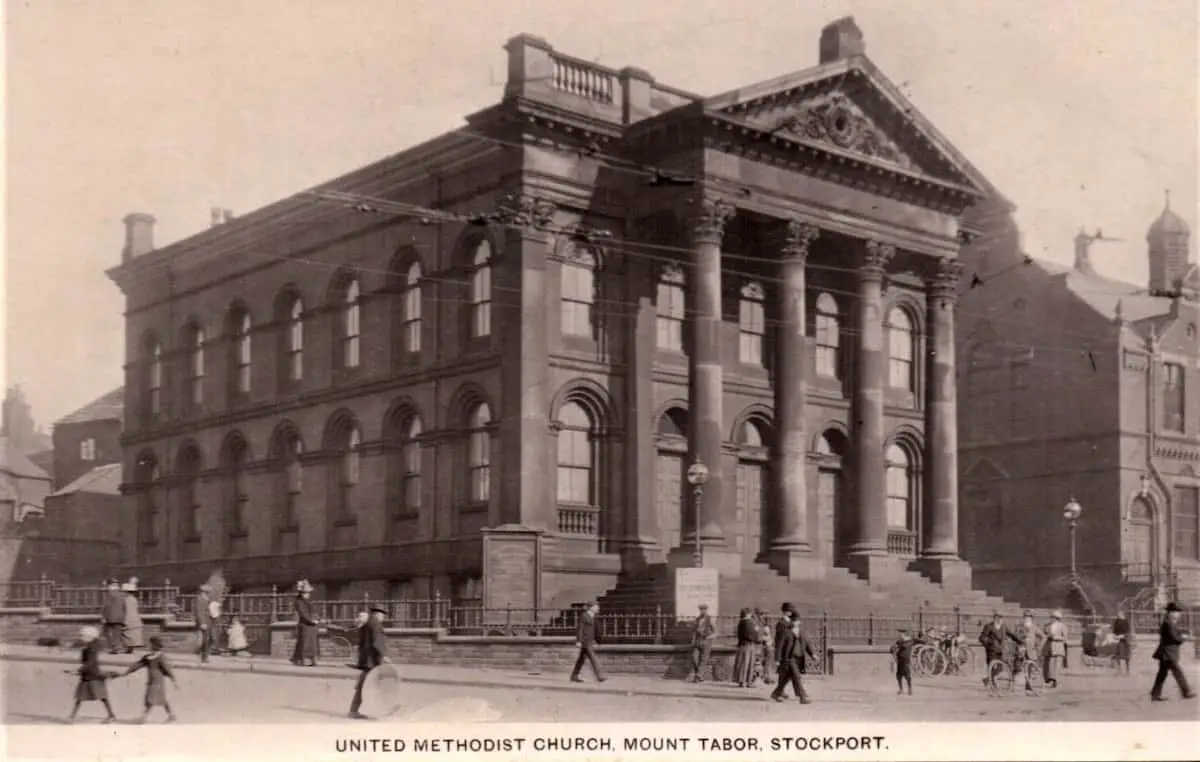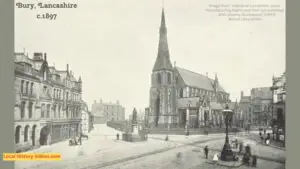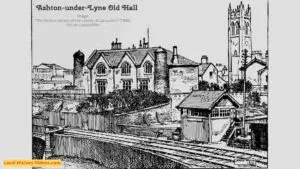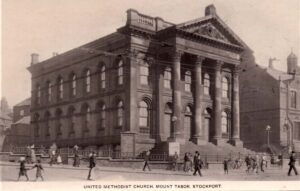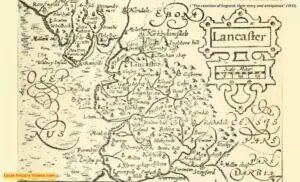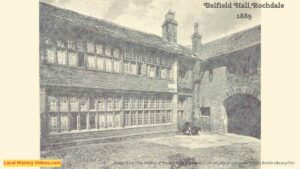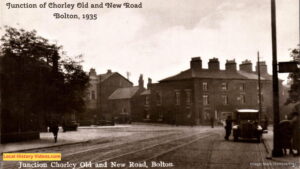Glimpse history through old images of Stockport, in North West England.
Old Photo of Turncroft Lane
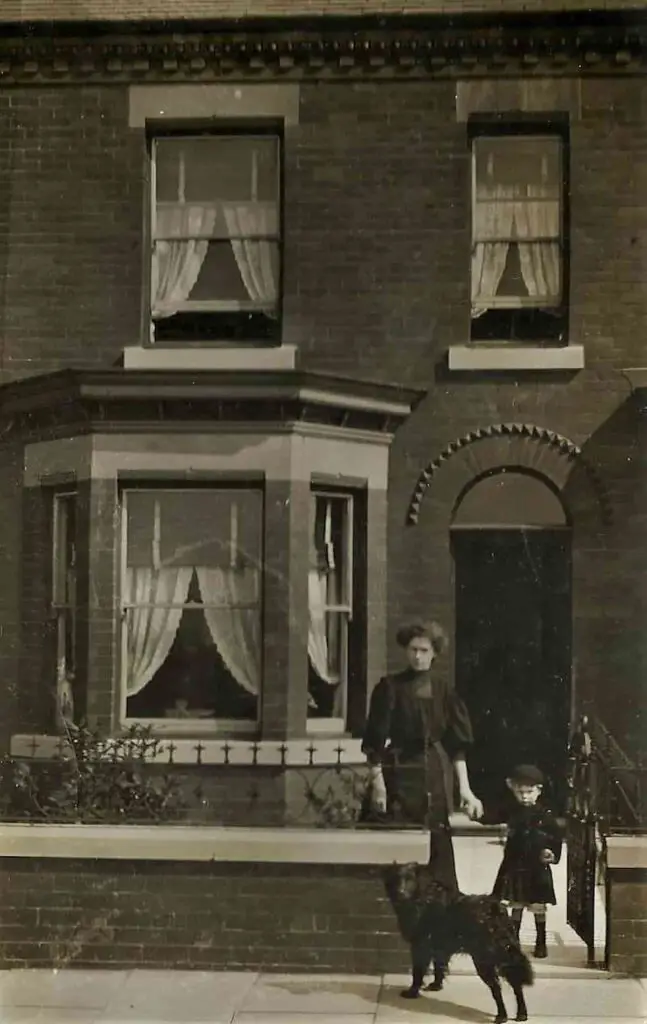
Virgin Mary Miracle 1947
At the 1947 May Sunday evening service in St Mary’s, Heaton Norris, the parish May Queen, seven year old Pauline Byrne, crowned the statue of St Mary the Virgin with a coronet of 22 cream roses.
A second coronet had been placed in the presbytery cellar the same week, ready to be placed on the statue in the second half of May, when the original coronet had faded. But it didn’t. And the two next annual coronets placed on the statue remained intact, even though identical coronets placed at the foot of the statue quickly faded.
In 1950, a different statue was used, and the rose crown behaved as normal, fading within a couple of weeks. The three coronets on the original statue remained intact.
Pilgrims flocked to the church, leaving enough donations to pay off the parish debt and to have the sanctuary decorated with marble.
Father Turner left the parish and the Diocese in 1954, taking the statue and three coronets with him. He went on a lecture tour of America, selling postcards of the statue.
This silent footage, recorded in 1947, includes images of the smoky rooftops across Stockport, as well as interior and exterior shots of St Mary’s.
Virgin Mary Miracle Stockport (1947) – British Pathé on YouTube
Oil Equipment Factory 1949
It’s a shame this newsreel only filmed inside the Stockport factory, so we don’t see the neighbourhood around it. But it’s a good record of the huge factories that local people used to work in.
Factory in Stockport produces oil equipment (1949) – British Pathé on YouTube
Stockport in 1966
A really good narrative accompanies these home movie images recorded back in 1966.
It starts with the General Election held that year, moves on to the streets, houses, power factory, viaduct, canal, Freemans chimney, entire streets about to be demolished, the new 1960s housing estates under construction, town centre shops, the buses at Mersey Square, the Market with prices in old money, and old houses at Heaton Mersey and Mersey Road.
Many of the locations seen here have disappeared over the years, while others have seen significant change.
Stockport in 1966 – Peter Scott on YouTube
Plane Crash 1967
69 holidaymakers returning from a package holiday in Majorca were killed when a Canadair C-4 Argonaut aircraft came down at Stockport, demolishing a garage and some warehouses, and destroying some cars.
Amazingly, it missed the nearby houses, preventing further loss of life. 12 people on board the plane, including the captain, survived.
This newsreel shows the damage caused, and many buildings in the surrounding area.
Plane Crash (1967) – British Pathé on YouTube
Stockport Buses
While these trailers for transport DVDs sold by PMPfilms focus on the buses, they also capture the sights and sounds of Stockport’s streets in past decades. You’ll also see local pedestrians, passing cars, and local businesses.
January 1989
STOCKPORT BUSES JANUARY 1989 – DaveSpencer32 on YouTube
June 1997
STOCKPORT BUSES JUNE 1997 – DaveSpencer32 on YouTube
Historic Book
Extract from
“Ancient and Modern · Volume 1”
by Henry Heginbotham
Published in 1882
Pages 74
A young man named Ludlam, called by the people “Captain Ludd,” was the leader. The excitement quickly extended to the cotton districts, where the object was to destroy the steam looms. The hand-loom weavers were easily induced to combine for this purpose because they believed that the introduction of the power-loom with its appliances would, to a great extent, supersede their hand labor.
One result of their combination in this neighborhood was that on the 14th March 1812, large crowds entered Stockport and, after breaking into the provision stores and distributing their contents, attacked the residences of some of the principal inhabitants.
The first windows they destroyed were those of the house of the late Peter Marsland, Esq., in Heaton Lane, now the business premises of Messrs. Clubley and Brown, but then a mansion standing alone in the midst of a beautiful garden, with its greenhouses and pleasant walks on the banks of the river Mersey, which flowed along as a clear and limpid stream.
The rioters then proceeded to Tiviotdale, where they attempted to break the windows of Mr. Marsland’s mill by throwing stones across the river.
After this, they passed along the Underbanks and up the Hillgate, demolishing the windows of John Birch, the constable, and attacking the houses of those who were obnoxious to them.
When they arrived at the Higher Hillgate, they made a fierce assault upon the factory of Mr. William Radcliffe (the inventor of the dressing-machine) and inflicted very serious damage.
The residences and factories of Messrs. Hindley and Bradshaw, Messrs. Bentley and Co., and those in Cooper and Thomas Street, as well as others in the neighborhood, shared the same fate.
Having committed these outrages, they went to the Edgeley Mills belonging to Mr. Goodair. At that time, these works stood in the fields at some distance from any other building, there being, in fact, but few houses between them and St. Peter’s Square. The rioters here broke the windows, through which a number entered into the mill, cutting out the warps and destroying the looms.
After this, the mob hastened to Edgeley Cottage, Castle Street, the residence of Mr. Goodair, which they forcibly entered, setting fire to the house, and making a bonfire of the furniture in the garden.
The Riot Act was read there by the Rev. Charles Prescot, the Rector of Stockport, and the military was sent for to support the yeomanry. The Scots Greys came, immediately followed by other Dragoons, and some infantry.
The people still refusing to disperse, the horse soldiers charged them with drawn swords, whilst the foot used their fixed bayonets. Many persons were wounded, and a great number taken prisoners.
After a preliminary inquiry before the Magistrates, some of them were discharged with a caution, while the ringleaders were committed to Chester Castle.
Riots of a similar character took place in various parts of the county with similar results. The chief offenders, twenty-eight in number, were tried by a Special Commission, presided over by Judges Dallas and Burton, which commenced its sittings on the 25th of May.
The prisoners arrested at Goodair’s were charged with having with divers others to the number of some hundreds assembled about the dwelling-house of John Goodair, of Edgeley, Manufacturer, and willfully and feloniously set fire to and burnt part of the said house.
At the close of the Commission, fourteen were condemned to death, only two of whom were executed.
Eight were transported for life, and the remainder imprisoned for various periods.
Among those thus imprisoned was a woman who, from the leading part she had taken in the disturbances, had received from the rioters the sobriquet of “Mrs. Ludd.”
While detained in the Stockport lock-up prior to her committal, she so enchanted her jailer that after her release from prison, he proposed to marry her.
To this, she consented, and thus became the mistress of that very place in which she had been held in durance vile.
From this romantic union, several persons are now descended, who occupy respectable positions in this neighborhood.
More Pictures of Old Stockport
Old Stockport in Greater Manchester, England, enjoyed through historic photos, vintage pictures & archive film. Browse history in these fascinating old images of a bygone era on my Pinterest Board at:
https://www.pinterest.co.uk/LocalHistoryVideos/stockport-old-photos-pictures
More about Greater Manchester
- Old Images of Greater Manchester, EnglandGlimpse history through old images of Greater Manchester, England.
- Old Images of Tyldesley, EnglandGlimpse history through old images of Tyldesley, in North West England, UK.
- Old Images of Heywood (Lancashire, now Greater Manchester)Glimpse history through old images of Heywood, traditionally in the English county of Lancashire, but part of Greater Manchester since April 1974.
- Old Images of Chadderton, EnglandGlimpse history through old images of Chadderton, in North West England, UK.
- Old Images of Ashton-in-Makerfield, EnglandGlimpse history through old images of Ashton-in-Makerfield, in North West England, UK.
- Old Images of Ashton-under-Lyne, UKGlimpse history through old images of Ashton-under-Lyne, in North West England, UK.
- Old Images of Stockport, EnglandGlimpse history through old images of Stockport, in North West England. Old Photo of Turncroft Lane Virgin Mary Miracle 1947 At the 1947 May Sunday evening service in St Mary’s, Heaton Norris, the parish May Queen, seven year old Pauline Byrne, crowned the statue of St Mary the Virgin with a coronet of 22 cream… Read more: Old Images of Stockport, England
- Old Images of Wigan, EnglandGlimpse history through old images of Wigan, traditionally in the county of Lancashire in North West England, but now in the area of Greater Manchester.
- Old Images of Rochdale, EnglandGlimpse history through old images of Rochdale, in North West England, UK. Rochdale Carnival 1927 Rochdale’s first annual exhibition and carnival was filmed in 1927, recording the streets crowded by local people as dressed-up adults, children, early cars and even an electric tram passed by in the parade. Rochdale carnival (1927) – British Pathé on… Read more: Old Images of Rochdale, England
- Old Images of Bolton, North West EnglandEnjoy a glimpse of history through old images of Bolton, in Greater Manchester, England, UK.

